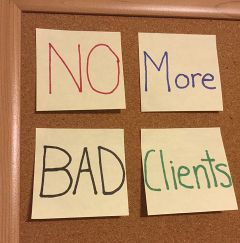
©Laura Spencer
The Internet is filled with horror stories about bad freelance writing clients. If you read freelance writing blogs and forums, as I do, you may start to think that almost every client is a bad one.
You’ll read about:
- Clients who never pay.
- Clients who contact you at all times of the day and night.
- Clients who are never satisfied.
- Clients whose projects never end.
- Clients who disappear.
And these are just a few of the horror stories out there. If you’ve been a freelance writer for any length of time, you probably have your own freelance client horror stories.
Good clients do exist. There are some easy steps you can take to drastically reduce the number of bad freelance clients you accept. In this post, I’ll explain what to do.
Step #1: Ask Thoughtful Questions
Even if the client provides a seemingly thorough description of the writing to be done, try to think of what could wrong and ask about it. Remember, it’s the questions you didn’t ask that cause problems.
If it’s possible, you may find it helpful to talk to a new client on the phone or face-to-face. Voice or body language cues can indicate that something is wrong, even if the client is saying all the right words.
Step #2: Set Expectations
There are three parts to setting expectations. You should:
- Set the client’s expectations.
- Set your own expectations.
- Get it in writing.
Start by setting your client’s expectations. You can do this in your initial emails and conversations with the client. Explain some of the boundaries you set on your writing. Boundaries could include:
- The hours you are available for work
- Your rush job policy (Most writers charge for rush work.)
- The number of revisions included in the price quoted
- Whether you are available for phone calls
- The amount you charge for your work
Of course, you’ll want to add your own boundaries to your list.
Once you’ve defined your boundaries, stick to them. This is where many freelance writers fail (including me). We think to ourselves, “I’ll compromise on my [price, rush job policy, work hours, whatever] just this once.”
Before we know it, we find ourselves working for a bad client who expects us to always make a compromise for them. Trust me. Don’t go down this path.
Finally, after you’ve established your freelance writing boundaries get it in writing. As I’ve described earlier, I use Quote Roller to create a proposal that becomes a contract once the client signs it.
Whatever you do, don’t rely on your memory or the client’s memory of what your writing agreement was.
Step #3: Fire Your Current Bad Clients
If you follow the steps above, any new clients you get should be good ones. But if you’re like many writers, you’re already working for some unreasonable clients.
It’s time to change that.
The next time one of those bad clients contacts you, explain your new policies. The bad client will either:
- Agree to the new policies. In this case, maybe they aren’t so bad after all. Maybe they just needed you to set some boundaries.
- Refuse to abide by the new policies. This could be a clear sign that the client doesn’t respect you. It’s probably time to move on.
Resolve that from now on that you’re only going to work with good clients who respect you. Because you’re worth it.
Your Turn
What boundaries do you set for your freelance writing clients? Share some examples in the comments.
